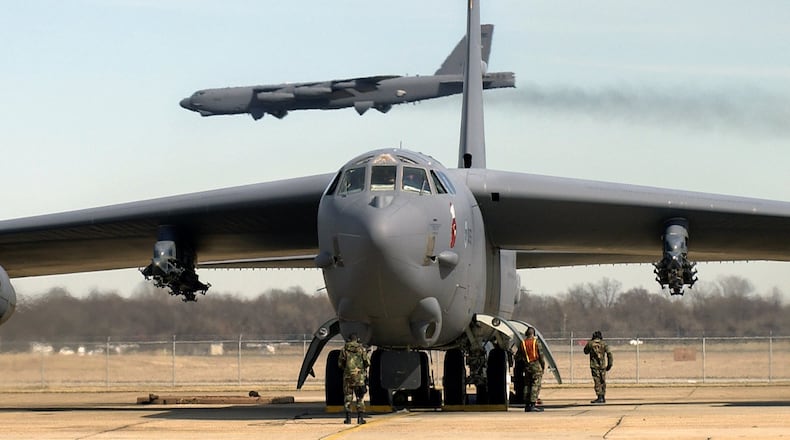Former Air Force pilot Kenneth J. Curry flew a badly damaged B-52 shot up from an anti-aircraft missile strike that left dozens of gaping holes spewing jet fuel like water faucets over North Vietnam in 1972.
The B-52D Stratofortress he once commanded is today a Cold War relic at the National Museum of the U.S. Air Force at Wright-Patterson, where the bomber has stood since 1979.
But the remnants of the workhorse fleet that last rolled off the assembly line during the Cuban Missile Crisis era in October 1962 will fly decades longer and a for century since it was designed.
“It’s just an amazing airplane,” Curry, 72, of Loveland, Colo., said in a telephone interview. “I think it’s a testament to our country in many ways to have had the capability to build such an airplane that would last so long.”
RELATED: Pilot relives ‘miracle’ flight on B-52
Boeing built 744 of the bombers, nicknamed Buff, or the Big Ugly Fat Fellow, but barely 10 percent remain flying. The Air Force has targeted buying at least 80 to 100 Northrop Grumman B-21s.
The Air Force decided to keep the more than half-century B-52s for decades more because of the availability of the airplane, its capabilities, maintenance demands and cost, among other factors, according to Capt. Mark A. Graff, an Air Force spokesman at the Pentagon.
‘Built to last’
The lumbering jet was “built to last, and its systems have been rejuvenated and replaced over the years,” said Richard Aboulafia, a senior aviation analyst with the Teal Group in Virginia. “The engines are the last missing piece. It can’t penetrate defended air space, but it is useful as a bomb truck. There’s no reason not to keep it.”
Dayton and Wright-Patterson have a key link to the bomber’s history. Wright-Patt’s bomber development chief pressed Boeing officials visiting the base in October 1948 to consider “pure jet power” instead of turboprops for the future jet. They responded and drafted the redesign over a weekend in a Dayton hotel room, a B-52 Stratofortress Association narrative says.
RELATED: Air Force names future stealth bomber
Over the years, the jet has flown bombing missions from southeast Asia to the Middle East. Today, it’s also sent overseas to deter adversaries in places from Europe to the South China Sea and the Korean peninsula.
B-52s had a mission capable rate of nearly 74 percent in fiscal year 2016, according to the Air Force. By comparison, the fleet of 62 B-1 and 20 B-2 bombers were available for missions about 51 percent of the time, statistics show.
Along with the Boeing-built plane’s large bomb load, the eight-engine jet can fly missions at low levels and high altitudes, Curry said.
Future air power
Loren B. Thompson, a senior defense analyst and defense industry consultant with the Virginia-based Lexington Institute, said none of the three bombers flying in the Air Force fleet today will be able to “safely penetrate well-defended air space in the future, not even the stealthy B-2.”
Even so, the B-52 will be armed with long-range stand-off weapons on nuclear missions, he said. “These stealthy cruise missiles are very difficult for even the most capable defenders to intercept,” he said in an email.
RELATED: Defense secretary focuses on technology, B-21 bomber in Wright-Patterson visit
“When the mission is non-nuclear and the enemy lacks good air defenses, as in the case of ISIS and the Taliban, the B-52 remains the most cost-effective ‘truck’ in the force,” he added. “Other bombers are harder to maintain in a high state of readiness.”
Aboulafia said the B-1B, built in the 1980s, “has been on borrowed time for years.”
“It can’t penetrate heavily defended airspace, and it’s extremely expensive to operate” and harder to replace than the B-52, he added.
“The B-2 retirement decision is the only mystery,” the aviation analyst said in an email. “I expect they feel that the B-21 is more capable and modern, with essentially the same function, so why not harvest the cost savings from retiring the fleet and put it into a few more B-21s.”
The B-52, By the Numbers
The Air Force announced recently it intends to will fly the B-52 through mid-century, surpassing the longevity of “younger” bombers, the swing-wing B-1 and stealthy B-2, both of which are set to be sidelined on the flight line in the 2030s. The B-52 has continuously flown missions with the Air Force since the 1950s.
Here’s a look at some facts about the iconic bomber:
First flight: 1954
Last production model year: 1962
Total number built: 744
Number still flying: 75
Range: 8,800 miles without aerial refueling
Weapons payload: 70,000 pounds
Speed: 650 mph
Crew size: Five airmen
Expected B-52 retirement: Around 2050
SOURCE: U.S. Air Force
About the Author
